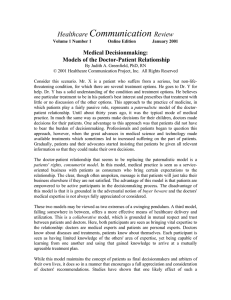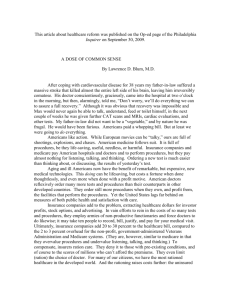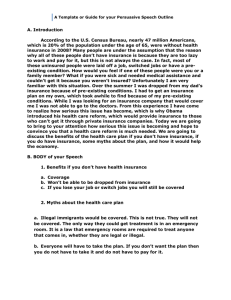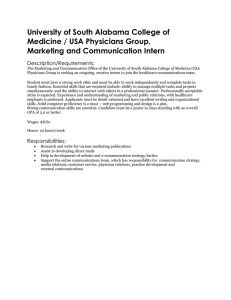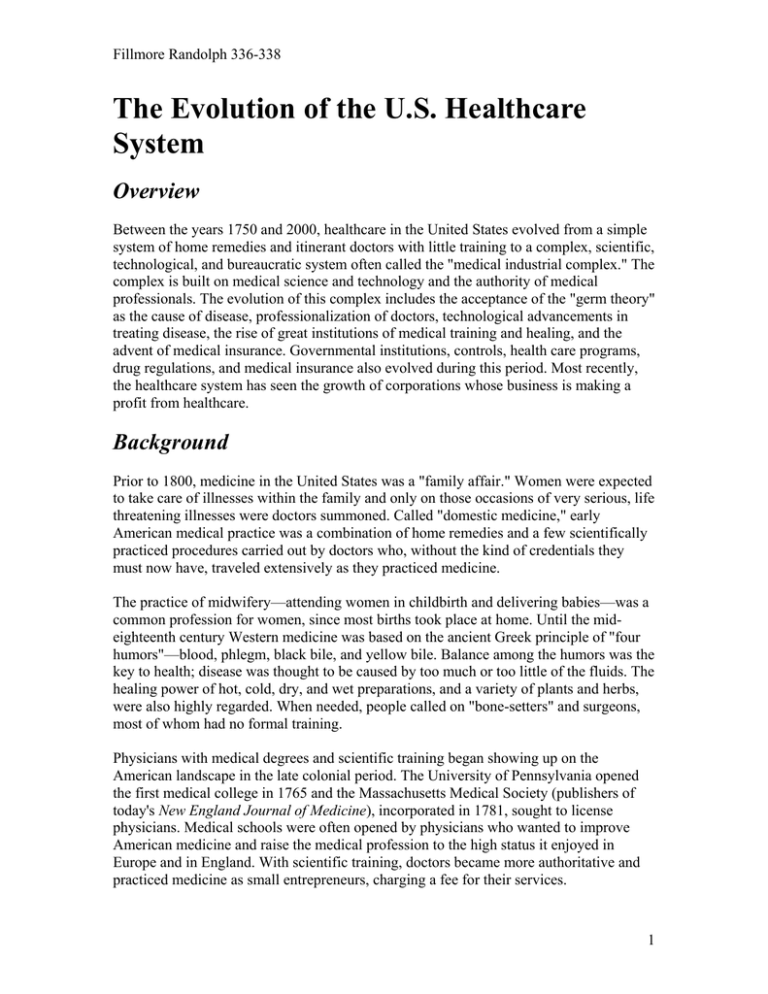
Fillmore Randolph 336-338
The Evolution of the U.S. Healthcare
System
Overview
Between the years 1750 and 2000, healthcare in the United States evolved from a simple
system of home remedies and itinerant doctors with little training to a complex, scientific,
technological, and bureaucratic system often called the "medical industrial complex." The
complex is built on medical science and technology and the authority of medical
professionals. The evolution of this complex includes the acceptance of the "germ theory"
as the cause of disease, professionalization of doctors, technological advancements in
treating disease, the rise of great institutions of medical training and healing, and the
advent of medical insurance. Governmental institutions, controls, health care programs,
drug regulations, and medical insurance also evolved during this period. Most recently,
the healthcare system has seen the growth of corporations whose business is making a
profit from healthcare.
Background
Prior to 1800, medicine in the United States was a "family affair." Women were expected
to take care of illnesses within the family and only on those occasions of very serious, life
threatening illnesses were doctors summoned. Called "domestic medicine," early
American medical practice was a combination of home remedies and a few scientifically
practiced procedures carried out by doctors who, without the kind of credentials they
must now have, traveled extensively as they practiced medicine.
The practice of midwifery—attending women in childbirth and delivering babies—was a
common profession for women, since most births took place at home. Until the mideighteenth century Western medicine was based on the ancient Greek principle of "four
humors"—blood, phlegm, black bile, and yellow bile. Balance among the humors was the
key to health; disease was thought to be caused by too much or too little of the fluids. The
healing power of hot, cold, dry, and wet preparations, and a variety of plants and herbs,
were also highly regarded. When needed, people called on "bone-setters" and surgeons,
most of whom had no formal training.
Physicians with medical degrees and scientific training began showing up on the
American landscape in the late colonial period. The University of Pennsylvania opened
the first medical college in 1765 and the Massachusetts Medical Society (publishers of
today's New England Journal of Medicine), incorporated in 1781, sought to license
physicians. Medical schools were often opened by physicians who wanted to improve
American medicine and raise the medical profession to the high status it enjoyed in
Europe and in England. With scientific training, doctors became more authoritative and
practiced medicine as small entrepreneurs, charging a fee for their services.
1
Fillmore Randolph 336-338
In the early 1800s, both in Europe and in the United States, physicians with formal
medical training began to stress the idea that germs and social conditions might cause and
spread disease, especially in cities. Many municipalities created "dispensaries" that
dispensed medicines to the poor and offered free physician services. Epidemics of
cholera, diphtheria, tuberculosis, and yellow fever, and concerns about sanitation and
hygiene, led many city governments to create departments of health. New advances in
studying bacteria were put to practical use as "germ theory" became the accepted cause
for illness. It was in the face of epidemics and poor sanitation, government-sponsored
public health, and healthcare that private healthcare began to systematically diverge.
Impact
As America became increasingly urbanized in the mid 1800s, hospitals, first built by city
governments to treat the poor, began treating the not-so-poor. Doctors, with increased
authority and power, stopped traveling to their sickest patients and began treating them
all under one roof. Unlike hospitals in Europe where patients were treated in large wards,
American patients who could pay were treated in smaller, often private rooms.
In the years following the Civil War (1865), hospitals became either public or private.
More medical schools and institutions devoted to medical research emerged. A trend
toward physicians needing more training led to the Johns Hopkins University's medical
school's requirement in 1893 that all medical students arrive with a four-year degree and
spend another four years becoming a physician.
Earliest efforts of doctors to create a unified professional organization started in the mid
1800s and, in 1846, the American Medical Association (AMA) was established. With
little early impact on American medicine, by the next century the AMA had great
influence over the politics and practice of medicine. An early AMA victory was the
regulation of drugs.
Just after the Civil War, nursing became professionalized with the establishment of three
training schools for nurses. While nursing began as a gender-based and female
stereotyped "nurturing" occupation, over the next 100 years nursing would become more
professionalized. By the late twentieth century, more nurses were receiving advanced
degrees and playing a greater role in the administration of health care. Rarely trained as
doctors even in the early twentieth century, by the 1980s women comprised up to half of
medical school student admissions.
As the nineteenth century ended, advancements in biology, chemistry and related medical
sciences meant that the great diseases—tuberculosis, yellow fever, diphtheria, cholera,
and others—were practically eliminated with the development of diagnostic tests and
vaccines. Extensive public health projects, aimed at fighting the causes of disease or to
prevent their spreading, raised the levels of public health. Healthcare extended into the
schools through school nurses.
2
Fillmore Randolph 336-338
By the early part of the twentieth century, doctors had more authority and were better
paid than ever before. Associations, such as the AMA and the American Hospital
Association (AHA), founded in 1899, became stronger. Employers and labor unions
began to offer a range of benefits to workers, including paid medical care. National health
insurance, such as provided by many European nations, became associated with socialism
and the concept became unpopular in the United States, opening doors for private health
insurance to cover the rising costs of medical care.
While private health insurance emerged prior to World War I, it was not until well after
the War and toward the end of the 1920s that the first large medical insurance company,
Blue Cross, was established.
The 1930s saw rising healthcare costs and an increasing number of health insurance
plans. At this time, doctors were paid by a system called "fee-for-service." New insurance
plans, such as Blue Cross and Blue Shield, allowed its members to pay both the costs of
hospitalization and for treatment by physicians. The AHA in the 1930s took an active
role in supporting group hospitalization plans. During World War II, a medical plan
started by Henry J. Kaiser for his employees featured a pre-paid program that paved the
way for Health Maintenance Organizations (HMOs) 40 years later.
The post-World War II era saw great expansions in the workforce, advancements in
medical science and medical care, and increasing healthcare costs. The Baby Boom
generation, the name given to the large numbers of children born just after World War II,
received ever-higher levels of medical and preventive care during the 1950s. Advances in
medicine in diagnostic techniques, such as x rays, life saving drugs, such as penicillin,
and inoculations against diseases, such as polio, had created an ever-deepening scientific
culture that included laboratory technicians, therapists, widening roles for nurses, and
increasing specialization among physicians.
These post-World War II technological advances professionalized the roles of nonphysician therapists and technicians, including respiratory therapists, physical therapists,
x-ray technicians, and laboratory technicians. Improved technology and increasingly
sophisticated treatments and therapies also pushed up cost of health care during the same
period.
U.S. government research and health institutions and programs, such as the National
Institutes of Health and the Centers for Disease Control, were established. The 1960s saw
the initiation of social programs to aid in the medical care of the aged (Medicare) and
poor (Medicaid). Prior to the founding of these institutions, the U.S. government had
founded other health programs and institutions, such as the Indian Health Service, the
U.S. Public Health Service, the Food and Drug Administration, and established an
executive cabinet-level agency, the Department of Health and Human Services.
Between the end of World War II and the late 1980s, most doctors were still independent
and compensated through fee-for-service. Through the powerful AMA and other
organizations, doctors had fought off political attempts at creating a nationalized,
3
Fillmore Randolph 336-338
universal coverage medical systems, such as those in Canada, the United Kingdom, and
in Europe.
Doctors did not apparently notice, however, the growth of Health Maintenance
Organizations (HMOs). By the mid 1980s, HMOs began to dominate both the
organization of health care and reimbursement to physicians. In the 1990s, HMOs and
their varieties would revolutionize the organization of health care in the United States and
provoke controversy among recipients of healthcare as well as doctors, who came to find
themselves in less control of their practices. Fee-for-service began to fade as doctors
increasingly found themselves working for corporations that made profits from pre-paid
healthcare by reducing the costs of healthcare, carefully restricting services, and focusing
on preventive healthcare.
Fee-for-service was slowly being replaced by "capitation," a system that paid doctors a
set fee from which they had to care for all of their patients, the sick and the well. Called
"managed care," this system also produced changes in the consumers' role in healthcare
as greater emphasis was placed on preventive medicine, consumer choice, and being
accountable for one's own health and healthcare. Communications advancements such as
the Internet and the World Wide Web in the 1990s added to the health information
available to consumers. Also at this time, consumer interest grew in "alternative
medicine," such as acupuncture, herbal preparations, and vitamin therapies. These
interests could be seen as a reaction against the medical industrial complex.
Computer and communications advancements also allowed for such practices such as
"telemedicine," a system utilizing the Internet by which patients could be diagnosed and
often treated by physicians at a distance.
Twenty-first-century technology promises to continue changing the nature, complexity,
and costs of healthcare. As knowledge increases about the genetic bases of disease, the
healthcare system will make greater use of gene therapies, developing ways to prevent
genetically caused diseases. Just as the impact of new technologies, such as x rays,
antibiotics, vaccines, and surgical advances changed early and mid-twentieth-century
medicine socially and scientifically, scientific and medical innovations, as well as social
movements and economic realities, will continue to shape twenty-first-century medicine
and health care.
RANDOLPH FILLMORE
Further Reading
Books
Biddle, Wayne. A Field Guide to Germs. New York: Henry Holt and Company, 1991.
Ehrenreich, John, ed. The Cultural Crisis of Modern Medicine. New York: Monthly
Review Press, 1978.
4
Fillmore Randolph 336-338
Inlander, Charles B. and Michael A. Donio. Medicare Made Easy: The People's Medical
Society. New York: MJF Books, 1999.
Muff, Janet, ed. Women's Issues in Nursing: Socialization, Sexism and Stereotyping. St.
Louis: The C.V. Cosby Company, 1982.
Starr, Paul. The Social Transformation of American Medicine. New York: Basic Books,
1982.
Periodical Articles
Mark, David, M.D., M.P.H and Richard M. Glass, M.D. "Impact of New Technologies in
Medicine: A Global Theme." The Journal of the American Medical Association (17 Nov.,
1999).
McGinnis, J. Michael, MD and Philip R. Lee, MD. "Healthy People 2000 at Mid
Decade." Journal of the American Medical Association 273, no. 14 (1996).
Copyright © 2009, Gale, Cengage Learning. All rights reserved, including the right of
reproduction in whole or in part in any form.
5

